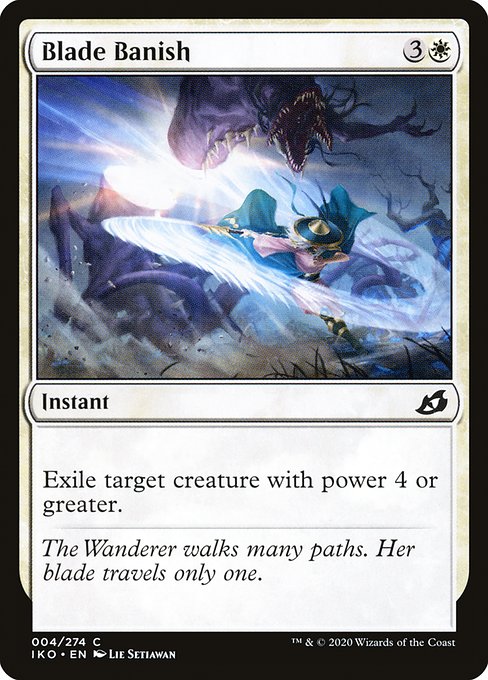
Image courtesy of Scryfall.com
Threat Assessment for Blade Banish in Modern MTG
In the Modern metagame, tempo wins and massive finishers often duel it out across a dozen turns. Blade Banish enters the fray as a measured, white instant from Ikoria: Lair of Behemoths with a precise aim: exile target creature with power 4 or greater. For four mana, this is not a catch-all removal spell, but it is a reliable tempo play when you face big bodies that threaten to outpace your earlier plans. Its narrow scope is both a feature and a challenge: it punishes the biggest threats while leaving smaller attackers to your other answers. The card’s value spikes in midrange mirrors, where you’re trying to slow an incoming haymaker just long enough to stabilize the board. 🧙♂️🔥
Card fundamentals in context
- Name: Blade Banish
- Mana cost: {3}{W} (four mana total)
- Type: Instant
- Rarity: Common
- Set: Ikoria: Lair of Behemoths
- Oracle text: Exile target creature with power 4 or greater.
As a common in a world where most red and green big threats loom large, Blade Banish is accessible to budget-oriented Modern decks and sideboards alike. Its exile clause is meaningful: removing a threat from the battlefield prevents not only combat damage but also any graveyard recursion or anthem effects that might bring it back into play. In other words, you’re not just trading for the moment—you’re possibly denying a longer-term engine. The color identity is pure white, and it slots neatly into control, midrange, or tempo shells that prize decisive cleanups over grindy trades. Occasionally you’ll see it shine against a late-game threat like a Primeval Titan or a Devoted Druid/Ishkanah-style behemoth when a game hinges on removing the biggest obstacle to victory. ⚔️
Where Blade Banish fits in Modern
The Modern landscape is littered with two- and three-mana removal spells that answer a wide variety of goals. Blade Banish sits in an interesting quadrant: it costs more than Path to Exile or Swords to Plowshares, but it has a very tight but potent condition—only targets with 4+ power. That makes it exceptionally strong against top-end threats such as Primeval Titan, Ulamog’s Crusher-type creatures, or large green monsters that are designed to take over the battlefield in a single swing. It’s less effective against a swarm of small creatures, where you’d want cheaper, unconditional removal or mass removals. This is where modern sideboard strategy shines—Blade Banish becomes a post-board answer to the “bomb” you expect opponents to tutor into play, rather than a catch-all answer you want in every matchup. 💎
Think of it as a specialized tool for a toolbox that includes Path to Exile, Return to Dust, a timely wrath, or stable blockers. In control mirrors or midrange slogs, Blade Banish can swing the pace by one solid turn: you remove a 4+ power threat, stabilize on board, and push toward a clean victory with your next set of plays. However, against hyper-aggro decks that flood the board with 1- and 2-power creatures, you’ll usually favor cheaper plays or早 removal that can clear multiple bodies at once. In that sense, Blade Banish rewards thoughtful timing and match-up awareness rather than raw card advantage. 🧙♀️
Threat assessment in play: when to cast and when to hold
- Target choice matters: Prioritize high-impact creatures with 4+ power that pose immediate finishers or big value engines. If your opponent drops a threat like a Gilded Goose level of midrange value, you’ll need to evaluate whether you can survive until you draw other answers—since you can’t wipe out every creature with a single spell, selection is key.
- Tempo vs. value: Casting Blade Banish too early can stall your own development. If you’re the control player, you may want to hold this spell for a turn when you can pair it with a follow-up threat or a port of the battlefield with a decisive long-term plan.
- Color and curve considerations: In white-heavy shells, Blade Banish acts as a clean, on-curve play to remove a late-game bomb while preserving your life total and board presence. Its four-mana cost requires careful sequencing with lands and accelerants, ensuring you don’t fall behind in the early turns.
- Against recursive threats: Because the spell exiles, it can thwart reanimation or bounce-back plans your opponent might rely on, which can tilt a game in your favor if you’re fighting through graveyard-based strategies.
From an accessibility perspective, Blade Banish is a nice case study in design: a clearly defined, limited removal that remains viable across many Modern matchups, but never overbearing or ubiquitous. Its Ikoria flavor—where power is measured and chosen with purpose—resonates with players who value precision in combat tempo as much as in deck construction. And yes, even in a digital-first era, the tactile satisfaction of landing a clean exile is something that players remember fondly—like finding a perfect line in a puzzle with a satisfying click. 🎲
As you experiment with threat assessment and deckbuilding, consider how a few copies in the sideboard can swing previously lopsided games. The card’s aura of strategic restraint invites players to think in terms of “when is the right moment to cut?” rather than “is there any moment I can remove this threat?” It’s a design that rewards thoughtful play and clear objectives—qualities any MTG enthusiast can appreciate while drafting, playing, or streaming a Modern event. ⚔️
And for those long nights spent poring over matchups, a little ergonomic comfort goes a long way. If you’re looking to enhance your desk setup while you map out your threat assessment strategies, this Foot-shaped Ergonomic Memory Foam Mouse Pad with Wrist Rest is a thoughtful companion for marathon planning sessions. The blend of form and function helps you keep focus during the long-winded mulligans and sideboard decisions. Foot-shaped Ergonomic Memory Foam Mouse Pad with Wrist Rest